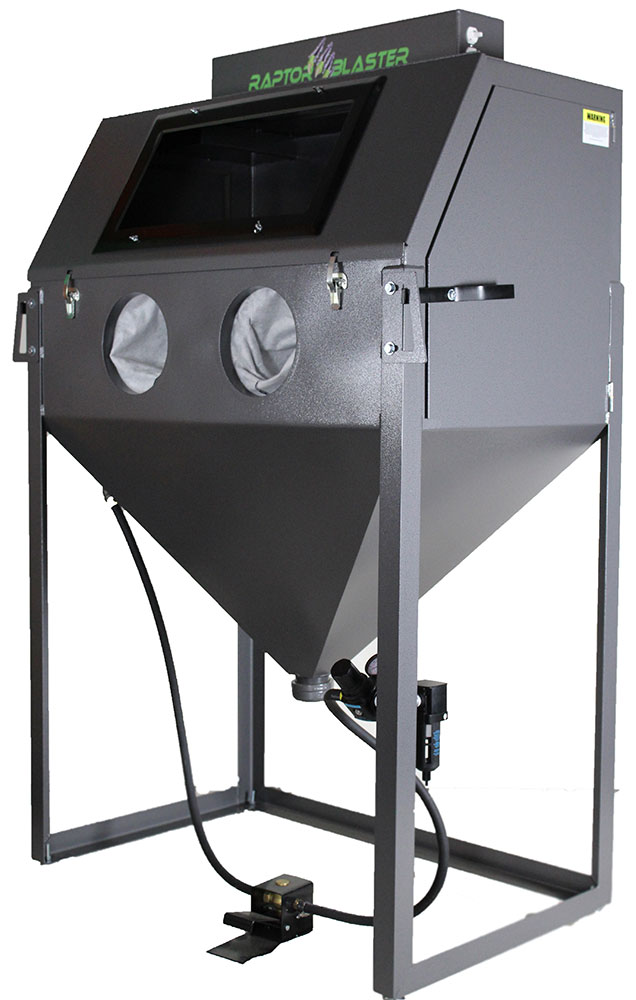
The most common type of dry blast cabinet is a siphon blast (aka suction blast) cabinet.
This type of blast cabinet has a line for compressed air, and a line that siphons abrasive media to the blasting gun. Here, the compressed air and abrasive mix together, and are expelled through the blast nozzle.
Siphon blast cabinets differ from pressure blast cabinets, where the abrasive media and air are compressed in a pressure pot, then expelled through a single hose through the blast nozzle.
Today we are talking strictly about troubleshooting abrasive flow issues in siphon blast cabinets.
This is a list of things to check if you have ruled out the most obvious problems.
Check the Air pressure
If your abrasive media flow seems off, check the air gun to see if the correct air pressure is being produced by the air compressor. Check the air compressor output pressure gauge to see if there is sufficient air pressure when the compressor runs. If there is an inadequate supply of air, the compressor may be faulty.
Particles may be clogging the line
If your blast gun is not drawing any abrasive, turn off the compressed air supply. Remove the nozzle from the blast gun, inspecting the passageway for any obstructions. Usually, particles like burrs, paint chips, rust fragments, decals or other particles are clogging the line at either the gun or the other end of the pickup line.
If there is air flow at the gun, but no abrasive is coming through, the abrasive pickup line is probably clogged.
You might need to add more abrasive
Another possibility if you have air flow, but no media, is that you need to add more abrasive to the tank. If there is still plenty of abrasive in the tank, check the valves. They may be obstructed or faulty.
Your abrasive media may be spent
Abrasive doesn’t last forever. If the abrasive has passed its maximum number of recycles, it needs to be disposed of and the abrasive in the tank replenished. Every type of abrasive media has a certain number of uses before it fragments into particles too small to effectively strip and clean a surface. If your blast media is at this point, even if the intake hose picks it up, the blasting power will be ineffective.
The blast nozzle may be worn out
Blast nozzles also wear out over time. The accelerated abrasive chews the nozzles up, widening the opening the compressed air and media is propelled through. The wider the nozzle orifice, the more air is needed to accelerate the media with the same force.
If your blasting gun seems to be lacking the force it did in the past, it may be time to get a fresh blast nozzle.
Drain the water trap (air filter) on your air compressor.
Water traps remove already condensed water in the air compressor line. Air enters one side, and circulates around the recess, where condensed water from the air accumulates at the bottom of the trap. This can be drained out. The air typically exits through a filter, which removes other small particulates from the air.
If the water trap on the air compressor is full, that condensed liquid water can evaporate and re-enter the air line to the blast cabinet.
The water trap fills up about once a week under regular use. If you live in an especially humid location, it may fill up even faster. You should drain the water trap every time you use the compressor in blasting to prevent rust.
This is one of the most important maintenance items for sandblasting cabinets. Excessive moisture in the air and abrasive lines can be the root cause of many problems with abrasive flow in sandblasters.
Removing unwanted moisture from hot, compressed air
If you have too much moisture in your air or abrasive lines, this can cause abrasive flow issues. This is most commonly caused by having an air compressor that is slightly undersized for the blast cabinet volume. If the air compressor does not have time to start, stop, and cool down during your blasting routine, it can cause excessive condensation.
To understand why this happens, let’s look at the steps in the abrasive blasting process.
Compressed air is under pressure, so the air molecules become slightly warmer than room temperature, due to friction. Eventually, this warms the tank above room temperature. This pressurized air is then introduced to the blast cabinet, which is cooler than the air in the tank and compressor. The blast cabinet is cooler than the air from the supply line because the dust collector blower is circulating air, cooling the inside of the cabinet.
The warm air from the supply line is usually the source of condensation. If you are blasting continually, and the air compressor has no time to cool down, the condensation may cause jamming in the lines. But how do you fix this?
Upgrading the air compressor system
For industrial blasting applications, you may need to add a multi-stage air drying system. A compressor that supplies 20 liters of air per second also supplies 24 liters of water per day.
That water needs to be removed, done in multiple stages. Of the initial 24 liters of water, 15 liters can be removed by an aftercooler. A refrigerated air dryer would then remove an additional 7 liter. For heavy duty blasting setups, you may et up a dessicant air cooler in a subsequent stage to remove the most amount of water vapor possible.
Summary
These are some of the most common issues with abrasive flow in siphon blast cabinets. If you are experiencing problems, or have a general question about abrasive blasting, contact us here, or call us at (916) 409-2458.
